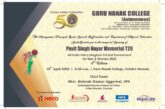COPYRIGHT OWNED BY MARYLBONE CRICKET CLUB
LAW 3 THE UMPIRES
1. Appointment and attendance
Before the match, two umpires shall be appointed, one for each end, to control the game as required by the laws,with absolute impartiality.The umpires shall be present on the ground and report to the Executive of the ground at least 45 minutes before the scheduled start of each day’s play.
2. Change of Umpire
An umpire shall not be changed during the match, other than in exceptional circumstances, unless he is injured or ill.If there has to be a change of umpire, the replacement shall act only as striker’s end umpire unless the captains agree that he should take full responsibility as an umpire.
3. Agreement with captains
Before the toss the umpires shall
(a) ascertain the hours of play and agree with the captains
(i) the balls to be used during the match. See Law 5 (The ball).
(ii) times and durations of intervals for meals and times for drinks intervals. See Law 15 (Intervals)
(iii) the boundary of the field of play and allowances for boundaries. See Law 19 (Boundaries).
(iv) any special conditions of play affecting the conduct of the match.
(b) inform the scorers of agreements in (ii), (iii) and (iv) above.
4. To inform captains and scorers
Before the toss the umpires shall agree between themselves and inform both captains and both scorers
(i) which clock or watch and back-up time piece is to be used during the match.
(ii) whether or not any obstacle within the field of play is to be regarded as a boundary. See Law 19 (Boundaries)
5. The wickets, creases and boundaries
Before the toss and during the match, the umpires shall satisfy themselves that
(a) the wickets are properly pitched. See Law 8 (The wickets)
(b) the creases are correctly marked. See Law 9 (The bowling,popping and return creases).
(c) the boundary of the field of play complies with the requirements of Laws 19.1 (The boundary of the field of play) and 19.2 (Defining the boundary-boundary marking).
6. Conduct of the game, implements and equipment
Before the toss and during the match, the umpires shall satisfy themselves that
(a) the conduct of the game is strictly in accordance with the Laws.
(b) the implements of the game confirm to the following
(i) Law 5 (The ball)
(ii) externally visible requirements of Law 6 (The bat) and Appendix E.
(iii) either Laws 8.2 (Size of stumps) and 8.3 (The bails) or, if
appropriate, Law 8.4 (Junior cricket).
(c) (i) no player uses equipment other than that permitted. See Appendix D. Note particularly therein the interpretation of ‘protective helmet’.
(ii) the wicket-keeper’s gloves comply with the requirements of Law 40.2 (Gloves).
7. Fair and unfair play
The umpires shall be the sole judges of fair and unfair play.
8. Fitness for play
(a) It is solely for the umpires together to decide whether either conditions of ground, weather or light or exceptional circumstances mean that it would be dangerous or unreasonable for play to take place.Conditions shall not be regarded as either dangerous or unreasonable merely because they are not ideal.
(b) Conditions shall be regarded as dangerous if there is actual and foreseeable risk to the safety of any player or umpire.
(c) Conditions shall be regarded as unreasonable if,although posing no risk to safety, it would not be sensible for play to proceed.
9. Suspension of play in dangerous or unreasonable conditions
(a) All references to ground include the pitch. See Law 7.1 (Area of pitch)
(b) If at any time the umpires together agree that the conditions of ground, weather or light, or any other circumstances are dangerous or unreasonable, they shall immediately suspend play or not allow play to start or to recommence.
(c) When there is a suspension of play it is the responsibility of the umpires to monitor conditions. They shall make inspections as often as appropriate, unaccompanied by any players or officials. Immediately the umpires together agree that the conditions are no longer dangerous or unreasonable they shall call upon the players to resume play.
10. Position of umpires
Each umpire shall stand where he can best see any act upon which his decision may be required. Subject to this over-riding consideration, the bowler’s end umpire shall stand where he does not interfere with either the bowler’s run up or the striker’s view.
The striker’s end umpire may elect to stand on the off side instead of the on side of the pitch, provided he informs the captain of the fielding side, the striker and the other umpire of his intention to do so.
11. Umpires changing ends
The umpires shall change ends after each side has had one completed innings. See Law 12.3 (Completed innings)
12. Consultation between umpires
All disputes shall be determined by the umpires. The umpires shall consult with each other whenever necessary. See also Law 27.6 (Consultation by umpires)
13. Informing the umpires
Throughout the Laws, wherever the umpires are to receive information from captains or other players, it will be sufficient for one umpire to be so informed and for him to inform the other umpire.
14. Signals
(a) The following code of signals shall be used by umpires.
(i) Signals made while the ball is in play
Dead ball -by crossing and re-crossing the
wrists below the waist.
No ball -by extending one arm
horizontally.
Out -by raising an index finger above
the head. (If not out,the umpire
shall call Not out.)
Wide -by extending both arms
horizontally.
(ii) When the ball is dead, the bowler’s end umpire shall repeat the signals above, with the exception of the signal for Out, to the scorers.
(iii) The signals listed below shall be made to the scorers only when the ball is dead.
Boundary 4 -by waving an arm from side to
side finishing with the arm
across the chest
Boundary 6 -by raising both arms above the
head.
Bye -by raising an open hand above
the head.
Commencement -by pointing to a raised wrist
of last hour with the other hand.
Five penalty runs -by repeated tapping of one
awarded to the shoulder with the opposite hand.
batting side
Five penalty runs -by placing one hand on the
awarded to the opposite shoulder.
fielding side
Leg bye -by touching a raised knee with
the hand.
New ball -by holding the ball above the
head.
Revoke -by touching both shoulders, each
last signal with the opposite hand.
Short run -by bending one arm upwards and
touching the nearer shoulder
with the tips of the fingers.
All these signals are to be made by the bowler’s end umpire except that for Short run, which is to be signalled by the umpire at the end where short running occurs.
However, the bowler’s end umpire shall be responsible both for the final signal of Short run to the scorers and for informing them as to the number of runs to be recorded.
(b) The umpire shall wait until each signal to the scorers has been separately acknowledged by a scorer before allowing play to proceed.
15. Correctness of scores
Consultation between umpires and scorers on doubtful points is essential. The umpires shall, throughout the match, satisfy themselves as to the correctness of the number of runs scored, the wickets that have fallen and, where appropriate, the number of overs bowled. They shall agree these with the scorers at least at every interval, other than a drinks interval, and at the conclusion of the match. See Laws 4.2 (Correctness of scores), 21.8 (Correctness of result) and 21.10 (Result not to be changed).
[Meaning for some important phrases in TAMIL: Impartiality-பாரபட்சமற்ற, Ascertain-உறுதிபடுத்திக்கொள்தல், Implements – நடைமுறை, interpretation – விளக்கம், exception – விதிவிலக்கு, foreseeable – எதிர்வரும், consideration – கருத்து]




